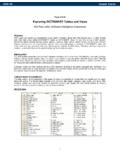Transcription of EXPLORING ELECTRIC VEHICLE ADOPTION IN ... - …
1 EXPLORING . ELECTRIC . VEHICLE . ADOPTION IN. NEW york city . JANUARY 2010. A GREENER, GREATER NEW york . The city of New york Mayor Michael R. Bloomberg EXPLORING ELECTRIC VEHICLE ADOPTION IN NEW york city : JANUARY 2010 1. This page left intentionally blank EXPLORING ELECTRIC VEHICLE . ADOPTION IN NEW york city . JANUARY 2010. Executive Summary 4. Context 6. Study Methodology 10. Study Findings 11. Conclusion 17. Appendix 18. Tables and Figures 20. A GREENER GREATER NEW york . Executive Summary PlaNYC, the city 's comprehensive sustainability plan, estab- vehicles. And regulations requiring VEHICLE fuel efficiency are lished an aggressive strategy to reduce the city 's greenhouse being strengthened in the , effectively mandating the intro- gas emissions in 2030 by 30% from 2005 levels.
2 As part of that duction of advanced VEHICLE technologies. overall goal, transportation emissions, which currently account for 22% of New york city 's total greenhouse gas emissions, While ELECTRIC VEHICLE technology offers the promise of reduc- would be reduced by 44% by 2030. PlaNYC also targeted a re- ing emissions of criteria pollutants and CO2, New york city 's duction in the city 's levels of harmful particulate emissions and unique transportation profile requires a tailored strategy to pollutants, to improve New york city 's air quality. promote the ADOPTION of EVs. Most New Yorkers do not own a car, and those who do may not drive them as far, or as fre- Public transportation, bicycling, and walking are critical ele- quently, as in other parts of the country.
3 In addition, many New ments of the city 's sustainable transportation system. In addi- Yorkers park their cars on the street or in commercial garages. tion to using fewer automobiles, the city can also become As a result, it is unclear who the target market for the first EVs more sustainable by making existing vehicles more efficient. In would be in New york city , how many EVs would be purchased, recent years, automotive manufacturers have begun to devel- what the key factors and barriers would be for early ADOPTION , op and produce a new generation of vehicles that are more and how EV usage would impact our electrical grid.
4 It is also energy efficient, emit fewer emissions, and use little or no gas- not clear what incentives infrastructure investments, subsi- oline. Among the most promising of these technologies are dies, or other actions may be needed to promote EVs. those that rely on electricity, either to enhance the distance a VEHICLE can travel before consuming gasoline, or through an To answer these questions, the city embarked on a study, in entirely ELECTRIC operation relying on battery storage technol- partnership with McKinsey & Company, a global management ogy. For those New Yorkers that will continue to rely on the consulting firm, to identify what factors would drive early con- automobile for their mobility needs, these ELECTRIC vehicles can sumers to purchase ELECTRIC vehicles, and what the city and offer an improvement over gasoline vehicles in reducing both other stakeholders could do to facilitate early ADOPTION of this urban pollution and greenhouse gas emissions, helping to technology in the short term.
5 McKinsey & Company is leading meet the city 's PlaNYC targets. And, although they are current- a global research effort that also includes the cities of Paris and ly more expensive to purchase than gasoline-powered vehicles, Shanghai to evaluate the evolution toward an ELECTRIC VEHICLE ELECTRIC vehicles offer the potential to save drivers significant ecosystem. The study has found that: sums of money over time, in fuel and maintenance savings by There is a potentially large group of early adopters willing some estimates, ELECTRIC vehicles may be 40% to 70% cheaper to change behavior to accommodate ELECTRIC vehicles.
6 A. to operate, depending on gasoline prices and how far a driver distinct population of early adopters is very positive about travels each year. ELECTRIC vehicles and willing to change habits to adapt to the In the last year, discussion of ELECTRIC vehicles (EVs) has become requirements of ELECTRIC vehicles. This may include, for exam- increasingly prominent in the United States. Manufacturers ple, switching from an on-street parking space to one in a local have announced more than a dozen highway-capable ELECTRIC parking garage to access necessary charging infrastructure. VEHICLE models for introduction between 2010 and 2012.
7 The The research also has found that New Yorkers' attitudes, rather Obama administration has committed more than $4 billion in than their driving or parking behaviors, are strong indications support of the design, manufacture, and purchase of ELECTRIC of their willingness to adopt ELECTRIC vehicles. Specifically, early 4 EXPLORING ELECTRIC VEHICLE ADOPTION IN NEW york city : JANUARY 2010. adopters have expressed a desire to espouse an environmen- Early adopters do not appear to need a high-density public tally friendly lifestyle, possess vehicles with the latest technol- charging network or local tax incentives.
8 While the availabil- ogy, and/or to challenge themselves to reduce their fuel usage. ity of charging at retail and curbside locations may be reassur- These early adopters will also most likely reside throughout ing to the average driver concerned about range limitations, the five boroughs. the study suggests that the earliest consumers will be willing to change their driving behavior and parking location, given These early adopters will likely outstrip the available supply their strong desire to purchase EVs. Thus, a dense public charg- of EVs to the New york market for at least the next five ing network will not be a strong priority for early adopters.
9 Years. The research projects that, by 2015, up to 14-16% of all Similarly, early adopters understand that ELECTRIC vehicles will new vehicles purchased by New Yorkers could be ELECTRIC ve- cost more than a comparable gasoline-powered VEHICLE and hicles. Despite this strong interest from early adopters, only they appear willing to pay a premium for the benefits that EVs limited numbers and types of ELECTRIC vehicles are expected to will offer them. So, providing tax incentives, in the form of a be offered in the New york region to meet projected demand. local sales tax credit or auto dealer rebate, may only serve to Given the long period from design to mass production, many subsidize early adopters who have already made the decision manufacturers plan to pilot vehicles in small numbers to test to purchase an EV, rather than attracting additional demand.
10 Their performance in varied conditions and environments be- fore dramatically expanding production. The projected level of ADOPTION of EVs should not threaten the stability of the ELECTRIC grid as long as most chargers are Thus, the study suggests targeting early policy actions to smart , allowing charging to take place during off-peak those issues that early adopters find most important. Ef- hours. The study indicates ongoing coordination is required to forts focused on other consumer segments should wait for support infrastructure planning that takes into account ELECTRIC several years. Given the likely strong demand among early vehicles and continues to adjust planning as the growth of adopters and the limited short-term supply of vehicles, initial ELECTRIC vehicles is better understood.














